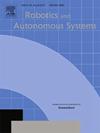The use of GA for parameters generation in fault-tolerant algorithm for manipulator control in case of axis failure
IF 4.3
2区 计算机科学
Q1 AUTOMATION & CONTROL SYSTEMS
引用次数: 0
Abstract
This paper presents a new fault tolerant control algorithm for the generation of a robot motion trajectory in an environment with obstacles, when one or two robot axes fail. The proposed method allows the robot to be controlled with obstacle avoidance in the event of axis failure at any time during the motion. An additional requirement for the algorithm was to determine, from among the generated steps that could be executed at a given point, the shortest path of the robot to the final position. However, due to the limitations of the GA used in the learning process, the total robot path was not the globally shortest. The algorithm works step by step. It uses a model of the robot working in the environment with obstacles and the reward function, defined in this article, to select the best possible robot move for each step. Two parameters are applied in this function, which values are generated using a genetic algorithm. At first, the proposed control method has been tested in the simulation using six arm robot model. The results are validated on a real Mitsubishi robot.
利用遗传算法进行参数生成的容错算法,实现了轴故障情况下的机械手控制
本文提出了一种新的容错控制算法,用于在有障碍物的环境中,当机器人的一个或两个轴失效时,机器人运动轨迹的生成。所提出的方法允许机器人在运动过程中任何时间发生轴故障时都能进行避障控制。该算法的另一个要求是,从给定点可执行的生成步骤中,确定机器人到最终位置的最短路径。然而,由于遗传算法在学习过程中的局限性,机器人的总路径不是全局最短的。该算法一步一步地工作。它使用机器人在有障碍物的环境中工作的模型和本文定义的奖励函数,为每一步选择最佳的机器人移动。在这个函数中应用了两个参数,它们的值是使用遗传算法生成的。首先,利用六臂机器人模型对所提出的控制方法进行了仿真验证。结果在一个真实的三菱机器人上得到了验证。
本文章由计算机程序翻译,如有差异,请以英文原文为准。
求助全文
约1分钟内获得全文
求助全文
来源期刊

Robotics and Autonomous Systems
工程技术-机器人学
CiteScore
9.00
自引率
7.00%
发文量
164
审稿时长
4.5 months
期刊介绍:
Robotics and Autonomous Systems will carry articles describing fundamental developments in the field of robotics, with special emphasis on autonomous systems. An important goal of this journal is to extend the state of the art in both symbolic and sensory based robot control and learning in the context of autonomous systems.
Robotics and Autonomous Systems will carry articles on the theoretical, computational and experimental aspects of autonomous systems, or modules of such systems.
 求助内容:
求助内容: 应助结果提醒方式:
应助结果提醒方式:


